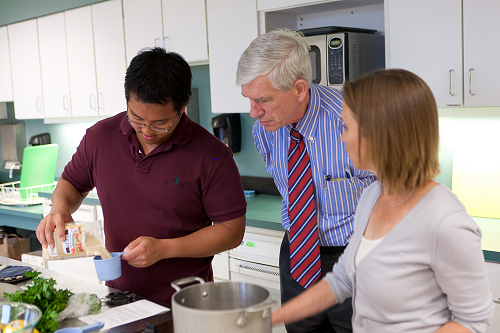Dinner is cooking in the spacious kitchen on the second floor of the Shaw Building and the aromas are mouth watering. Seven doctors, most of them cardiac fellows, are busily cutting, mixing, melting and sautéing, creating a heart-healthy dinner with guidance from nutritionists Jennifer Fournier, RD, LDN, and Victoria Andersen, MS, RD, LDN.
Normally, Fournier and Andersen teach this cooking class to cardiac rehab patients, people who are looking to improve their eating habits after getting a harsh wakeup call from their own bodies. But tonight, it’s the doctor’s turn to experience what their patients would be learning during the optional cooking classes that are part of the cardiac rehab services of the Division of Preventive and Behavioral Medicine.
 First-year cardiac fellow Peter Shaw, MD, left, and Jim Chesebro, MD, receive instructions from nutritionist Victoria Andersen on cooking quinoa. Photo by Rob Carlin |
Fournier’s goal is to teach these doctors something about the science of healthy eating, in addition to letting them know what services are available to their patients. The fellows, who have been through four years of residency and are now getting specific training in cardiology through the three-year fellowship program, also learn about food presentation—a smaller plate makes a portion seem bigger, for example.
“We recognize that cardiologist, or doctors in general, don’t get a lot of nutrition education, and the education they get is very much in scientific, micronutrient-based biochemistry,” said Fournier. “So we’re turning the chemistry into food because that’s what patients eat and that’s what they want to hear about.”
In this particular class, the participants created a chocolate dessert made with tofu, and burgers made with salmon. One pair chopped up apples and broccoli for a colorful salad, while another group worked with a grain called quinoa. Zahi Rafeq, MD, deemed his bean guacamole too bland, and he asked Fournier if it was OK to add salt. Add a bit and taste again, she said.
An added benefit to the class is a chance to learn new recipes and cooking techniques, and share a delicious meal with fellow doctors. James H. Chesebro, MD, professor of medicine and one of the few non-fellows in the group, gamely chopped up carrots and parsley for the lemon and garlic quinoa salad, but he admitted his wife was looking forward to him bringing home new recipes so she could try them.